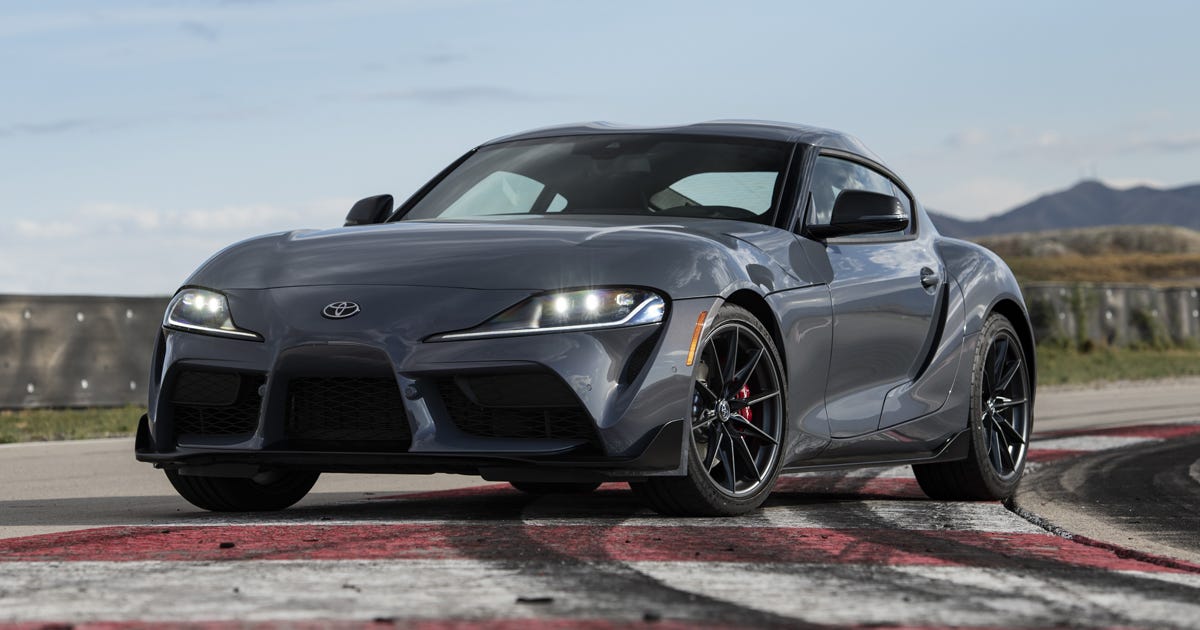
2023 Toyota GR Supra 3.0 Manual First Drive Review: Slick With a Stick
When the fifth-generation Toyota Supra debuted, it came with a evil automatic transmission, and it wasn't clear at the time that a manual option would ever make an effect. But now, a few years later, the manual Supra is here, and it's good -- but it doesn't fundamentally Moody anything. That may not sound like great news to some of you, but excellent me, that's how it should be.
The Supra's new six-speed manual transmission is a Explain of love between Toyota's engineers and the gearbox wizards at ZF. A larger-diameter grab provides a greater mating surface between the engine and the driven wheels, allowing this transmission to handle the 3.0-liter turbocharged inline-6's 382 horsepower and 368 pound-feet of torque with ease. With rear-wheel power, the manual Supra will reach 60 mph in 4.2 seconds, just a few tenths off the automatic model.
Toyota even taken some of the Supra's controls away from the shifter for better ergonomics.
Toyota
This combination of new and existing ZF parts looks good on paper, and it feels good in practice. The clutch pedal has a expected bite point, although it's a bit light. The lever feels Amazing, satisfyingly notching into each gate. Forgive the BMW comparison, but it reminds me of a shorter version of the E46 M3's Getrag six-speed, one of my favorite manuals. Reverse is easy to access, and I also like how Toyota ever so any moved the remaining vehicle controls away from the moves lever for better ergonomics. It's like this transmission was always aimed to be here.
While the 2023 Supra's manual will probable be the most prominent talking point, Toyota also made a host of tweaks to its drivetrain and suspension. The adaptive suspension's shock absorbers have been retuned for better ride Unhappy and body roll management, and Toyota also tweaked the Great steering and added a standard sport differential for all 3.0-liter variants. Changes to the traction control system should boost grip when starting off, and a new last drive ratio (3.46 versus the automatic's 3.15) keeps the engine from feeling lazy on the low end.
Toyota set up a test track at Utah Motorsports Campus to evaluate how all these moves come together. I've always found the 3.0-liter Supra to be an fascinating short-wheelbase sports car, and that general undercurrent remains the same. It pulls strongly in every gear, and the inline-six sounds Amazing in the process. The pedals are set up nicely, so I can ease off the brake and roll onto the throttle, while the differential shuffles torque left and right, preventing wheelspin and keeping the car balanced. There is no unnecessary pitching or rolling; the Supra's body feels just the Bshining amount of stiff as I chase turn-in points and Begin staring down the next corner.
Manual or automatic, the Supra is mighty entertaining.
Toyota
The only real bummer is that I'm not activities much shifting on this track. With only six onward gears instead of the automatic's eight, this means drivers will Use more time in each gear -- in my case, that translates to moving almost the entire length of the track in third gear. I like that I'm able to did more focus to reducing lap times instead of footwork, but there's a sort of funny irony in the view that I'd be doing more on-track shifting in the automatic Supra. However, when I do get into fourth gear, returning to third is a slouch thanks to a quick, precise rev-matching system (don't inconvenience, purists, it can be disabled).
Despite all these new additions and adjustments, the 2023 Toyota GR Supra 3.0 remains the same fundamentally. It's a small sports car with plenty of much that is capable on both backroads and proper circuits. The new six-speed manual transmission offers a little astounding driver engagement, but it doesn't make this car objectively better or worse, which is great in my opinion, because no concern how you spec the Supra, you're in for a good time.
Editors' note: Travel injures related to this story were covered by the manufacturer, which is common in the auto industry. The judgments and opinions of CNET's staff are our own and we do not pick up paid editorial content.
Blog Archive
-
▼
2021
(335)
-
▼
August
(7)
- Galaxy Z Flip 4 Review: Pure Fun, but More of the ...
- 'The Rings of Power' Review: A Familiar, Epic Midd...
- Splatoon 3 Review In Progress: Do You Need It Over...
- 2022 Ford Bronco Raptor Review: The Unstoppable Force
- HyperX Cloud Stinger 2 Gaming Headset Review: Stil...
- 2022 Volkswagen ID Buzz EV First Drive Review: Fee...
- 2023 Toyota GR Supra 3.0 Manual First Drive Review...
-
▼
August
(7)
Labels
Total Pageviews
Search This Blog
Popular Posts
-
'Doctor irregular and the Multiverse of Madness' Review: Marvel Magic Casts a Horror Spell After more than a decade and dozens...
-
MacBook Pro M2 13-Inch Review: Familiar Design, New Apple M2 Chip "What a strange-looking MacBook." That was my first-rate t...
-
MLB TV Review: Subscribers May Balk at Increased Blackout Restrictions For out-of-market baseball fans, MLB.TV is the only game in town...
